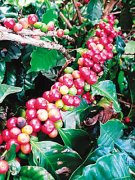Introduction to the Export of Niya Coffee the Central Mountain region of Nyeri Ethiopia
The increase in the number of Niya coffee is obvious. From 1969 to 1970, 800000 bags were exported, and from 1985 to 1986, the export volume increased to 2 million bags. Now the yield is stable at 1.6 million bags, with an average yield of about 650kg per hectare.
Even before coffee prices skyrocketed in recent years, the average price of coffee in Kenya had been rising. Prices from 1993 to 1994 were 50% higher than they were 12 months ago. The price rise is mainly the result of increased demand.
Some buyers, especially Japanese businessmen, have expressed dissatisfaction with the Kenyan coffee industry system. others say the quality of coffee in the country has declined and point out that buying directly from farmers may be a way to improve quality. but in any case, Kenya's detailed rules and regulations and sound procedures are a model for all coffee-producing countries to learn from.
Kenyan Coffee became more famous with the sensation of the Hollywood movie Out of Africa. Karen, the heroine played by Meryl Streep (Maryl Streep), is a writer and coffee plantation owner. Many people may still remember the beautiful scenery and the magnificent sunset in the film, but what is even more unforgettable is Karen's dream of having a coffee plantation in Africa, Kenya, which comes from the mountains of Kenya. The local Bantu language means "ostrich". Fossilized human skulls from about 2.5 million years ago were unearthed in the territory. By the 7th century AD, some commercial cities had been formed along the southeast coast, and Arabs began to do business and settle here.
The country is divided into seven provinces (PROVINCE) and one provincial special zone, with districts (DISTRICT), townships (DIVISION) and villages (LOCATION) below the provinces. The seven provinces are Central Province (CENTRAL), Rift Valley Province (RIFT VALLEY), Nyanza Province (NYANZA), Western Province (WESTERN), Oriental Province (EASTERN), Northeast Province (NORTH EASTERN) and Coastal Province (COAST). One provincial special zone is the Nairobi Special Zone (NAIROBI AREA).
The Kenyan national emblem established in 1963 centers on a shuttle-shaped shield emblem consistent with the national flag, with a golden lion holding a spear and a shield emblem on each side. The white rooster with an axe in the back is the emblem of the African National Union of Kenya. According to the local tradition, the rooster symbolizes the new life. The two lions embody national sovereignty and national dignity, as well as the ties between Kenya and Britain.
Under the foot of the double Lions is the Kenyan volcano, the second largest mountain in Africa. It treads on fertile land, covered with coffee, oranges, sisal tea, corn and pineapple, and is full of fruit and fragrance. This is a microcosm of the peaceful life of the Kenyan people and the prosperity of the country. The brown ribbon under the national emblem is marked with the word "coexistence" in Swahili, expressing the desire of the Kenyan people for peace, fraternity, freedom and equality.

Important Notice :
前街咖啡 FrontStreet Coffee has moved to new addredd:
FrontStreet Coffee Address: 315,Donghua East Road,GuangZhou
Tel:020 38364473
- Prev

Java, the earliest coffee growing area in Indonesia, introduces Lindong, Sumatra.
Jakarta, the capital of Indonesia, located in the northwest of Java, is the largest city in Southeast Asia. In addition, Indonesia's second and fourth largest cities are located on the island of Java. Java is the first region in Indonesia to grow coffee and has taken the lead in the world coffee market as early as the 18th century. The famous Java mocha, made from Java coffee mixed with Yemeni mocha, represents the coffee impression of an era. In addition
- Next

El Himalaya Semi-Sunned Red Bourbon FincaHimalaya Boutique Coffee
Located in Santa Ana, a famous production area in the Apaneca Mountains at an altitude of 1500 meters, Himalaya Manor is one of the few manors managed by Aida Batlle. The varieties grown are mainly Bourbon. Coffee beans from the estate are washed at the El Divisadero treatment plant in Ataco under the name Mauricio Salaverria and then stored on African elevated beds.
Related
- Does Rose Summer choose Blue, Green or Red? Detailed explanation of Rose Summer Coffee plots and Classification in Panamanian Jade Manor
- What is the difference between the origin, producing area, processing plant, cooperative and manor of coffee beans?
- How fine does the espresso powder fit? how to grind the espresso?
- Sca coffee roasting degree color card coffee roasting degree 8 roasting color values what do you mean?
- The practice of lattes: how to make lattes at home
- Introduction to Indonesian Fine Coffee beans-- Java Coffee producing area of Indonesian Arabica Coffee
- How much will the flavor of light and medium roasted rose summer be expressed? What baking level is rose summer suitable for?
- Introduction to the characteristics of washing, sun-drying or wet-planing coffee commonly used in Mantenin, Indonesia
- Price characteristics of Arabica Coffee Bean Starbucks introduction to Manning Coffee Bean Taste producing area Variety Manor
- What is the authentic Yega flavor? What are the flavor characteristics of the really excellent Yejasuffi coffee beans?

